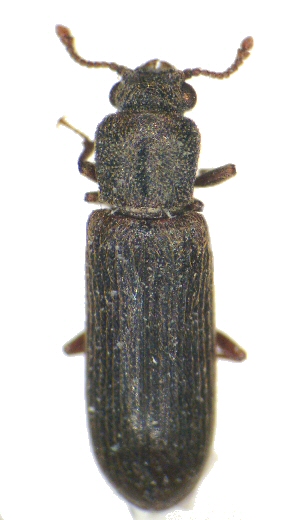Powderpost Beetle
 Scientific Name
Scientific Name
Lyctus spp.
Symptoms
Powderpost beetles can be found in dead wood as well as dried and cured lumber. Damage occurs to many wood products such as rafters, joists, flooring, molding, paneling, crating, furniture, antiques, tool handles, gun stocks, fishing poles, baskets, and ornamental objects. Beetles of three different families can cause similar damage. These include the true powderpost beetles (family Lyctidae), the false powderpost beetles (family Bostrichidae), and the deathwatch beetles (family Anobiidae). The southern lyctus beetle attacks only large-pore hardwoods. They are most commonly found in ash, hickory, and oak but have been known to damage dead and dried black walnut, elm, locust, maple, osage orange, persimmon, poplar, sycamore, sassafras, and wild cherry. They attack seasoned hardwood and sapwood timbers found in woodwork, flooring, structural wood, furniture, tool handles, and firewood. Adult beetles can emerge from wood stored in the home and infest structural wood or furniture. The most commonly reported infestation site in Oklahoma is in ash cabinets or trim around doors, windows, etc. in homes.
Adult exit holes are round and 1/32 to 1/16 inch in diameter. Larvae of lyctids and anobiids cause most of the damage while adult bostrichids contribute to damage. "Flour or talc-like" frass is packed in the larval galleries and falls out of exit holes and cracks. This fine sawdust is often found on the floor or counter tops in areas where infestations of powderpost beetles occur.
Most powderpost beetle infestations are in wood or wood products before the wood is purchased. Because development is slow and inconspicuous, the infestation may be several years old before they are discovered. There is no need for extreme haste in treatment. Carefully inspect wood at the lumbermill, lumberyard, or other storage area. Individuals remodeling or renovating old buildings and salvaging lumber from old wooden structures should be cautious. Farm-sawed lumber is often a source of infestation. Dust off the suspected wood surface and wait 24 hours to notice whether fresh dust appears around emergence holes. Live beetles or new exit holes indicate activity. Wood no longer infested need not be treated, but weakened timbers may need to be replaced. It may also be simpler to replace infested wood if only a small area of trim is involved. Most wood-infesting beetles will not reinfest wood that is painted, varnished, waxed, or shellacked. Larvae already in the wood at the time it is finished (varnished-lacquered) will develop and emerge. Wooden artifacts or furniture can be super cooled at 0 F for several weeks or super heated at 140 to 150 F for two to four hours to kill infestations. For new construction, use kiln dried lumber (dried a minimum of eight hours at 130 to 140 F and 80 percent relative humidity). Most beetles do not develop in wood with a moisture content below 10 to 15 percent.
Life Cycle
The length of the life cycle for lyctids is usually three months to one year, but this can be extended to several years depending on species, temperature, and starch content of the wood. It is not unusual to have infestations reported in newly constructed homes. Newly emerged adults mate and the females lay eggs on or in the pores of wood. Lyctids and anobiids may reinfest the wood from which they emerged while bostrichids seldom do.
Description
Adult lyctids are flattened, slender, reddish brown to black, and vary from 3/32 to 7/32 inch long. The antennae have a two-segmented club. The head extends forward and is visible from above. The most common species in Oklahoma is the southern lyctus beetle (Lyctus planicollis LeConte). The following discussion will apply mostly to this species; however, biology and control of most other species is quite similar.
Control
Please contact your local county extension office for current information.
